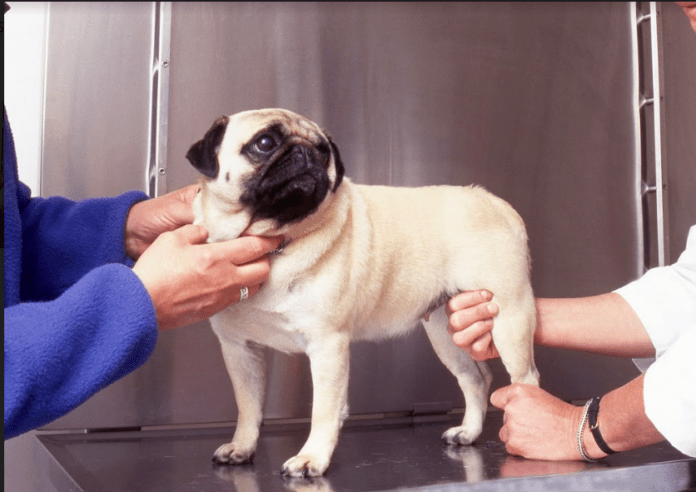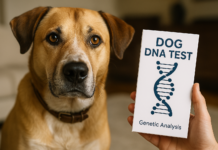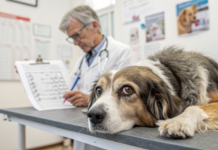Last Updated on December 30, 2024 by Dogs Vets
Osteoarthritis In Dogs: 5 Signs And Treatment Options
Keeping an eye out and helping maintain your dog’s health is one of the essential responsibilities of dog owners. This is because dogs can’t speak or get the health services they need, so it’s up to their owners to ensure they get check-ups or observe if they’re in pain. This is because dogs could be born with or later develop health problems. best treatment for dogs with arthritis.
Early detection is crucial, as prompt intervention can significantly improve a dog’s quality of life. The best treatment for dogs with arthritis often includes a combination of weight management, physical therapy, joint supplements like glucosamine and chondroitin, and prescription medications to manage pain and inflammation. In some cases, advanced therapies such as stem cell treatment or platelet-rich plasma (PRP) therapy may also be recommended. Consulting a veterinarian to develop a personalized treatment plan ensures that your dog receives the care and support they need to live a comfortable and active life despite arthritis.
One of these is osteoarthritis, which is one of the common complications with dogs. Identifying this problem early on is crucial for you to get your dog the right treatments such as light therapy. For more information on what light therapy is and how it can help dogs, it’s recommended you read this helpful article.
What Is Osteoarthritis?
In osteoarthritis or degenerative joint disease (DJD), the cartilage in joints deteriorates and causes an inflammation that continuously worsens. The breakdown in the cartilage is caused by different factors such as stress, disease, injuries, or even age.
Causes Of Osteoarthritis In Dogs
There are certain conditions and activities that can cause osteoarthritis in dogs. If your dog exhibits some of these or has gone through some of these experiences, you might want to have them checked for osteoarthritis or other common problems:
- Big dogs
- Age
- Genetics
- Obesity
- Malnutrition
- Poor confirmation
- Infections that can affect the joints
- Hip or elbow dysplasia
- Fractures and ligament injuries
- Repetitive athletic stress
Signs Of Osteoarthritis In Dogs
If you’re worried about whether your dog has osteoarthritis or is at risk of developing it, here are some signs and symptoms:
-
Limping And Difficulty Moving
Osteoarthritis can be painful, so one of the things to look out for is signs of physical struggles. For instance, they might not be able to run or walk comfortably, so they rarely get up. If they do, they usually have trouble doing it or have a limp as they walk.
-
Weight Gain
This symptom is closely related to how dogs with osteoarthritis tend to be less active. Because they don’t feel comfortable moving around, they usually have no means of getting rid of the extra weight gained, so they might be heavier than usual.
-
Irritable Or Dislikes Being Touched
If your dog is irritable or starts to dislike being touched, they might have osteoarthritis. This is because you might be accidentally petting the part of their body in pain. If not, they might want to protect that spot, so they react negatively if you pet them or reach out to them.
-
Decreased Muscle Mass Around The Spine And Limbs
Depending on where the osteoarthritis is located or originates, you might be able to observe less muscle mass in that area. This is because muscles can shrink without enough movement and exercise.
-
Having Problems With Potty Training
Suddenly, your dog might be having ‘accidents’ in the home even if they’re correctly house trained. This might also be due to osteoarthritis since they can’t correctly move to go to the right spot to do their business, or they can’t posture themselves well to urinate or defecate in the right area.
Other Physical Symptoms
- Swollen joints
- Thickening and scarring of the joint membrane
- Fluid within the joint
- Bony outgrowths
- Bone thickening or hardening underneath the cartilage
If these are some things that you observe in your dog, get them checked immediately so any problems can be immediately identified and properly diagnosed.
It’ll also help your dog get the medication and treatments that can help them deal with the pain and improve their situation.

Preventing Osteoarthritis In Dogs
Unfortunately, there’s no known cure for osteoarthritis. So, it’s better to ensure they’re healthy and find ways to prevent it, especially if your dog is more likely to get the disease. Here are some ways that you can help your dog avoid it:
- Keeping a healthy diet
- Getting enough exercise
- Taking joint supplements
Osteoarthritis Treatments For Dogs
Osteoarthritis can be a severely painful experience for dogs. And because there’s no cure, it’s crucial to find ways to help with the proper treatment. This will help them feel more comfortable through the ordeal through pain regulation, inflammation reduction, and more.
-
Joint Supplements For Dogs
Since osteoarthritis is a common health problem for dogs, joint supplements are available. These are meant to increase water retention in the cartilage to help cushion the joints better. At the same time, joint supplements can also help reduce inflammation and heal damage in joints. Some of the ingredients in these supplements are glycosaminoglycans, antioxidants, omega-3 fatty acids, glucosamine, and chondroitin.
-
Medication
After a check-up and getting diagnosed with osteoarthritis, the vet might prescribe certain medications. These might include painkillers or non-steroidal anti-inflammatory drugs (NSAIDs), depending on the severity of the disease. However, NSAIDs can have side effects such as losing appetite, stomach and intestine inflammation, and vomiting. However, it’s especially detrimental if the dog already has kidney or liver problems. This type of medication might be paired with regular blood work.
-
Red Light Therapy
Red light therapy is another effective treatment for dogs that have elbow osteoarthritis. This type of phototherapy uses red light wavelengths, which are terrific for healing wounds faster, reducing inflammation, and better collagen production.
-
Surgery
Depending on the severity of the disease, there might be different treatments available for dogs. Usually, surgery is the last choice, and it’s often reserved for when the joint disease is too severe. For instance, elbow, hip, and stifle replacements have been developed and evolved through the years to help dogs who have degenerative joint diseases.
-
Weight Management
Because weight affects osteoarthritis, it’s necessary to manage their weight. For instance, if the dog is overweight and it worsens their osteoarthritis, you might be advised by the veterinarian to help your dog lose weight. And because they might be gaining weight due to the disease, it’s essential to pay more attention to monitoring and maintaining their weight.
-
Physical Rehabilitation
Osteoarthritis affects your dog’s daily life down to menial activities like walking around and going outside. Thus, physical rehabilitation will be needed to help rebuild muscles and get their strength up.
Here’s what you can expect from physical rehabilitation for dogs:
- Exercise
- Thermal modalities
- Extracorporeal Shock Wave Therapy
- Transcutaneous Electrical Nerve Stimulation
- Therapeutic Laser
Conclusion
Osteoarthritis can be extremely painful for dogs, and it can even affect other aspects of their health since it reduces their physical activity. So, it’s essential to find the best ways to help your dog by ensuring they’re cared for in a way that could help prevent osteoarthritis.
But at the same time, it’s necessary to get dogs checked in case they have DJD to get the treatment or medication they need to improve their condition.
Facts Check
We hope you enjoyed this article… What are your thoughts on Osteoarthritis In Dogs?
Рleаse feel free to share with us in the comments section below!

















